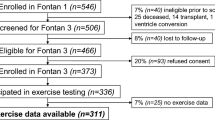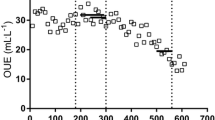Abstract
Cardiopulmonary exercise testing (CPET) is a common method of evaluating patients with a Fontan circulation. Equations to calculate predicted CPET values are based on children with normal circulation. This study aims to create predictive equations for CPET variables solely based on patients with Fontan circulation. Patients who performed CPET in the multicenter Pediatric Heart Network Fontan Cross-Sectional Study were screened. Peak variable equations were calculated using patients who performed a maximal test (RER > 1.1) and anaerobic threshold (AT) variable equations on patients where AT was adequately calculated. Eighty percent of each cohort was randomly selected to derive the predictive equation and the remaining served as a validation cohort. Linear regression analysis was performed for each CPET variable within the derivation cohort. The resulting equations were applied to calculate predicted values in the validation cohort. Observed versus predicted variables were compared in the validation cohort using linear regression. 411 patients underwent CPET, 166 performed maximal exercise tests and 317 had adequately calculated AT. Predictive equations for peak CPET variables had good performance; peak VO2, R 2 = 0.61; maximum work, R 2 = 0.61; maximum O2 pulse, R 2 = 0.59. The equations for CPET variables at AT explained less of the variability; VO2 at AT, R 2 = 0.15; work at AT, R 2 = 0.39; O2 pulse at AT, R 2 = 0.34; VE/VCO2 at AT, R 2 = 0.18; VE/VO2 at AT, R 2 = 0.14. Only the models for VE/VCO2 and VE/VO2 at AT had significantly worse performance in validation cohort. Of the 8 equations for commonly measured CPET variables, six were able to be validated. The equations for peak variables were more robust in explaining variation in values than AT equations.

Similar content being viewed by others
References
Anderson PA, Sleeper LA, Mahony L, Colan SD, Atz AM, Breitbart RE, Gersony WM, Gallagher D, Geva T, Margossian R, McCrindle BW, Paridon S, Schwartz M, Stylianou M, Williams RV, Clark BJ 3rd (2008) Contemporary outcomes after the Fontan procedure: a Pediatric Heart Network multicenter study. J Am Coll Cardiol 52:85–98
Avitabile CM, Leonard MB, Zemel BS, Brodsky JL, Lee D, Dodds K, Hayden-Rush C, Whitehead KK, Goldmuntz E, Paridon SM, Rychik J, Goldberg DJ (2014) Lean mass deficits, vitamin D status and exercise capacity in children and young adults after Fontan palliation. Heart
Bansal M, Fiutem JJ, Hill JA, O’Riordan MA, Zahka KG (2012) Oxygen pulse kinetics in Fontan patients during treadmill ramp protocol cardiopulmonary exercise testing. Pediatr Cardiol 33:1301–1306
Chen JK, Chen TW, Chen CH, Huang MH (2009) Oxygen uptake for cycling in relation to body composition: a pilot study. The Kaohsiung J Med Sci 25:544–551
Cooper DM, Weiler-Ravell D (1984) Gas exchange response to exercise in children. Am Rev Respir Dis 129:S47–S48
Cooper DM, Weiler-Ravell D, Whipp BJ, Wasserman K (1984) Growth-related changes in oxygen uptake and heart rate during progressive exercise in children. Pediatr Res 18:845–851
Cordina RL, O’Meagher S, Karmali A, Rae CL, Liess C, Kemp GJ, Puranik R, Singh N, Celermajer DS (2013) Resistance training improves cardiac output, exercise capacity and tolerance to positive airway pressure in Fontan physiology. Int J Cardiol 168:780–788
Cordina R, O’Meagher S, Gould H, Rae C, Kemp G, Pasco JA, Celermajer DS, Singh N (2013) Skeletal muscle abnormalities and exercise capacity in adults with a Fontan circulation. Heart 99:1530–1534
Fernandes SM, McElhinney DB, Khairy P, Graham DA, Landzberg MJ, Rhodes J (2010) Serial cardiopulmonary exercise testing in patients with previous Fontan surgery. Pediatr Cardiol 31:175–180
Giardini A, Hager A, Pace Napoleone C, Picchio FM (2008) Natural history of exercise capacity after the Fontan operation: a longitudinal study. Ann Thorac Surg 85:818–821
Giardini A, Balducci A, Specchia S, Gargiulo G, Bonvicini M, Picchio FM (2008) Effect of sildenafil on haemodynamic response to exercise and exercise capacity in Fontan patients. Eur Heart J 29:1681–1687
Giardini A, Fenton M, Derrick G, Burch M (2013) Impairment of heart rate recovery after peak exercise predicts poor outcome after pediatric heart transplantation. Circulation 128:S199–S204
Goldberg DJ, French B, McBride MG, Marino BS, Mirarchi N, Hanna BD, Wernovsky G, Paridon SM, Rychik J (2011) Impact of oral sildenafil on exercise performance in children and young adults after the Fontan operation: a randomized, double-blind, placebo-controlled, crossover trial. Circulation 123:1185–1193
Goldberg DJ, Avitabile CM, McBride MG, Paridon SM (2013) Exercise capacity in the Fontan circulation. Cardiol Young 23:823–829
Hager A, Weber R, Muller J, Hess J (2014) Predictors of sildenafil effects on exercise capacity in adolescents and adults with Fontan circulation. Clin Res Cardiol 103:641–646
Hume R (1966) Prediction of lean body mass from height and weight. J Clin Pathol 19:389–391
James FW, Kaplan S, Glueck CJ, Tsay JY, Knight MJ, Sarwar CJ (1980) Responses of normal children and young adults to controlled bicycle exercise. Circulation 61(5):902–912
Kato TS, Collado E, Khawaja T, Kawano Y, Kim M, Farr M, Mancini DM, Schulze PC (2013) Value of peak exercise oxygen consumption combined with B-type natriuretic peptide levels for optimal timing of cardiac transplantation. Circ Heart Fail 6:6–14
Kempny A, Dimopoulos K, Uebing A, Moceri P, Swan L, Gatzoulis MA, Diller GP (2012) Reference values for exercise limitations among adults with congenital heart disease. Relation to activities of daily life-single centre experience and review of published data. Eur Heart J 33:1386–1396
Kouatli AA, Garcia JA, Zellers TM, Weinstein EM, Mahony L (1997) Enalapril does not enhance exercise capacity in patients after Fontan procedure. Circulation 96:1507–1512
Loomba RS, Danduran ME, Dixon JE, Rao RP (2014) Effect of Fontan fenestration on regional venous oxygen saturation during exercise: further insights into Fontan fenestration closure. Pediatr Cardiol 35:514–520
Madan P, Stout KK, Fitzpatrick AL (2013) Age at Fontan procedure impacts exercise performance in adolescents: results from the Pediatric Heart Network Multicenter study. Am Heart J 166(365–372):e361
Mancini DM, Eisen H, Kussmaul W, Mull R, Edmunds LH Jr, Wilson JR (1991) Value of peak exercise oxygen consumption for optimal timing of cardiac transplantation in ambulatory patients with heart failure. Circulation 83:778–786
Mays WA, Border WL, Knecht SK, Gerdes YM, Pfriem H, Claytor RP, Knilans TK, Hirsch R, Mone SM, Beekman RH 3rd (2008) Exercise capacity improves after transcatheter closure of the Fontan fenestration in children. Congenit Heart Dis 3:254–261
Meadows J, Lang P, Marx G, Rhodes J (2008) Fontan fenestration closure has no acute effect on exercise capacity but improves ventilatory response to exercise. J Am Coll Cardiol 52:108–113
Paridon SM, Mitchell PD, Colan SD, Williams RV, Blaufox A, Li JS, Margossian R, Mital S, Russell J, Rhodes J (2008) A cross-sectional study of exercise performance during the first 2 decades of life after the Fontan operation. J Am Coll Cardiol 52:99–107
Prakash A, Travison TG, Fogel MA, Hurwitz LM, Powell AJ, Printz BF, Puchalski MD, Shirali GS, Yoo SJ, Geva T, Pediatric Heart Network I (2010) Relation of size of secondary ventricles to exercise performance in children after Fontan operation. Am J Cardiol 106:1652–1656
Rhodes J, Ubeda-Tikkanen A, Clair M, Fernandes SM, Graham DA, Milliren CE, Daly KP, Mullen MP, Landzberg MJ (2013) Effect of inhaled iloprost on the exercise function of Fontan patients: a demonstration of concept. Int J Cardiol 168:2435–2440
Disclosures
The NIH/NHLBI Pediatric Heart Network Fontan Cross-Sectional Study dataset was used in preparation of this work. Accessed from https://www.pediatricheartnetwork.org. The authors are solely responsible for the design and conduct of this study, all study analyses, the drafting and editing of the manuscript, and its final contents.
Author information
Authors and Affiliations
Corresponding author
Rights and permissions
About this article
Cite this article
Butts, R.J., Spencer, C.T., Jackson, L. et al. Estimating Equations for Cardiopulmonary Exercise Testing Variables in Fontan Patients: Derivation and Validation Using a Multicenter Cross-Sectional Database. Pediatr Cardiol 36, 393–401 (2015). https://doi.org/10.1007/s00246-014-1020-5
Received:
Accepted:
Published:
Issue Date:
DOI: https://doi.org/10.1007/s00246-014-1020-5




